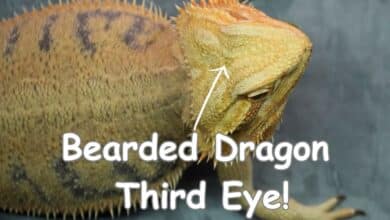Why is My Bearded Dragon Mouth Yellow? (Cause & Care Guide)

Reptiles like bearded dragons as pets are becoming more popular as time goes on and information about these creatures becomes more readily available. Caring for your bearded dragon does not have to be a stressful experience, but you might be wondering what is causing its mouth to be yellow.
A bearded dragon’s mouth turns yellow when it is experiencing a medical condition called jaundice. Jaundice is most often a symptom of an underlying issue like fatty liver disease.
Every pet owner wants to make sure his pet stays healthy, so you should keep reading to learn more about jaundice in order to keep your bearded dragon healthy.
Contents
What Is Jaundice?
You might be wondering what jaundice is if you own a bearded dragon. Jaundice is a disorder that is caused when the body produces too much of the substance bilirubin. This is a disorder that can occur in humans (most commonly babies) as well as animals like a bearded dragon.
Bilirubin is the substance that is formed when red blood cells are broken down. This substance is made in the liver and stored in the gallbladder. Bilirubin has a yellow tint in general, so when it is overproduced (causing jaundice) it can cause the person or animal’s eyes, gums, or skin to become yellow as well.
More often than not, jaundice is a symptom of fatty liver disease. Fatty liver disease is usually caused by obesity and lack of exercise in bearded dragons. Bearded dragons should eat a balanced diet that is not high in fat in order to avoid fatty liver disease.
To prevent obesity, along with eating a balanced diet, your bearded dragon should also exercise regularly.
What Are the Symptoms of Jaundice?
Jaundice is characterized in bearded dragons by the yellow tinge of their skin, eyes, and gums. The tip of a bearded dragon’s tongue can be yellow normally, so it can be difficult to diagnose based on just the color change.
Jaundice most likely is not the only symptom your bearded dragon has. Since jaundice is usually a symptom of fatty liver failure, you should also look for other symptoms along with the yellowing tint of your bearded dragon’s skin and mouth.
Fatty liver disease can cause a host of symptoms. They include fatigue and lethargy, weakness, depression, anorexia, bloating, and swollen limbs. If you noticed any of these symptoms included with jaundice, you will most likely want to schedule a vet appointment for your bearded dragon.
Is Jaundice Disease Serious?
Jaundice in and of itself is not serious; however, jaundice as a symptom of fatty liver disease can be very serious if left untreated.
If you catch these symptoms in the early stages of fatty liver disease, the recovery rate of bearded dragons is very good.
What Should You Do If Your Bearded Dragon Gets Jaundice?
When bearded dragons get jaundice as a result of fatty liver disease, you should schedule an appointment with your reptile veterinarian. Your veterinarian will likely suggest several different treatment courses and tests in order to determine the diagnosis and treat it.
The veterinarian may draw blood to check for cholesterol, triglyceride, and uric acid levels as fatty liver disease can increase these levels. If your bearded dragon’s white blood cell count is elevated, this could mean that it has a bacterial infection.
The physical exam could prompt your veterinarian to take x-rays of your bearded dragon’s abdomen. Through the x-ray, he or she will be able to see if the liver is enlarged. In the event it is, he or she may take a biopsy of the liver.
Treatment for your bearded dragon may include fluids to prevent dehydration and tube feeding if he is not eating. In addition, it may also need vitamin injections and amino acid supplements.
How Much Money Will Treatment for Jaundice Cost?
To treat jaundice, you will have to treat fatty liver disease. Unfortunately, vet visits for exams only range from around $70 up to $100s of dollars. This price will increase for every option chosen to diagnose and treat fatty liver disease and jaundice.
On average, treatment can cost from $300 to $3,000. The cost also increases if a hospital stay and intensive care are required, which can cost up to $1,000 a day.
Will My Bearded Dragon Be Okay?
Your bearded dragon should be okay so long as you seek treatment at the first sign of a change in its color. You should not wait around if you notice that your bearded dragon’s eyes, skin, or mouth area (not just the tip of its tongue) start to turn yellow.
The yellowing of these parts is a sign of something more serious happening in your bearded dragon’s body, so you should be sure to seek a veterinarian if this happens.
Conclusion
The potential for your bearded dragon to develop fatty liver disease and jaundice is not something that should prevent you from enjoying the bond you will develop with your pet. These conditions are completely preventable with proper food and exercise.





